Looking to give your deck a fresh new look?
We delve into the world of pressure washing and deck stain removal. Learn about pressure washing, how it works on decks, and its impact on deck stain removal.
Discover the various pressure washer types, alternatives for removing deck stains, and the proper way to pressure wash your deck without harming the stain.
Get all the tips and tricks you need to keep your deck looking its best!
Contents
Pressure washing is a highly effective method of cleaning various surfaces using high-pressure water spray to remove dirt, grime, and other residues.
This process is particularly beneficial as it saves time and effort compared to traditional cleaning methods. Pressure washing can be applied to a wide range of surfaces, including concrete driveways, wooden decks, brick walls, and even vehicles. One of the key advantages of pressure washing is its ability to thoroughly clean surfaces, leaving them looking fresh and renewed. It is crucial to adjust the pressure settings and use appropriate techniques to prevent damage and ensure a successful cleaning outcome.
Uncover more: How To Clean External Cladding
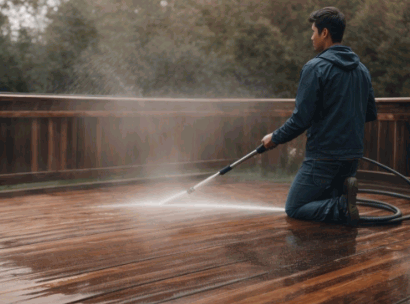
Deck stain is a protective coating applied to wooden surfaces, such as decks, to enhance their appearance, protect them from damage, and prolong their lifespan.
Applying deck stain helps prevent moisture penetration, UV ray damage, and fungal growth, all of which can lead to rotting or warping of the wood.
There are various types of deck stains available, such as transparent, semi-transparent, and solid stains, each offering different levels of protection and aesthetic appeal.
The application of deck stain can be done through brushing, rolling, or spraying, depending on personal preference and the type of stain chosen.
Regular maintenance, including cleaning and reapplying stains as needed, is crucial to keep the wooden deck looking vibrant and protected for years to come.
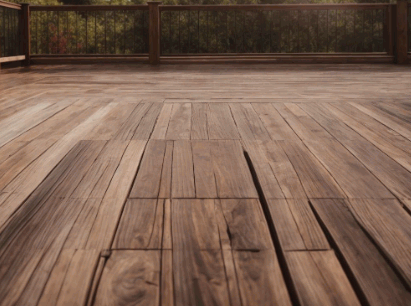
Pressure washing on decks involves using high-pressure water to clean and remove dirt, mould, stains, and debris from the surface of the deck, restoring its appearance and preparing it for maintenance.
This process is highly effective in revitalising various surfaces, including wood, concrete, and composite materials. When pressure washing a deck, it's crucial to adjust the pressure settings based on the surface material to avoid damage. Pressure washing can easily tackle tough stains like oil spills or mildew, enhancing the overall look and longevity of your deck.
Choosing the right pressure washer for your cleaning needs is crucial to ensure optimal results and prevent damage to surfaces.
Regarding selecting a pressure washer, it's essential to consider the type of surfaces you'll be cleaning. Different surfaces require different pressure washing techniques to avoid any harm. For example, soft washing is suitable for delicate surfaces like painted walls or wooden decks, while power washing is ideal for stubborn stains on concrete driveways or fences.
The power washing capabilities of a pressure washer are also vital. Adequate power ensures efficient cleaning, especially for tougher grime and dirt buildup. Adjustable nozzle tips and pressure settings allow you to customise the water pressure according to the surface you are cleaning, providing versatility and control over the cleaning process.
Pressure washing has the capacity to remove deck stain, depending on the pressure, technique, and the type of stain applied to the deck's surface.
It's important to tread carefully when using pressure washing for stain removal. While it can be highly effective at stripping away old, worn-out deck stains, there's a risk of causing damage if not done correctly. For example, using too much pressure or holding the sprayer nozzle too close to the surface can lead to damage to the deck.
In scenarios where the stain has deeply penetrated the wood or if it's a particularly stubborn stain, removing it solely through pressure washing may prove challenging. In such cases, combining pressure washing with specialised cleaning agents or stripping solutions can enhance the process.
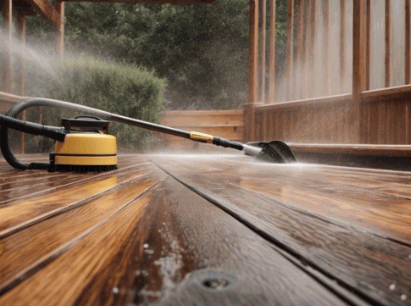
Several factors can influence the removal of deck stain, including the type of stain used, the age of the stain, the condition of the deck's surface, and the cleaning method employed.
Regarding different stains, oil-based stains are known to penetrate deeply into the wood, making them a bit trickier to remove than water-based alternatives. The age of the stain plays a crucial role; newer stains tend to be more stubborn. The overall condition of the deck's surface is another vital aspect to consider as rough or damaged surfaces can make the removal process more challenging.
Cleaning products designed specifically for deck stain removal can be very effective, but for tough stains or intricate deck designs, seeking professional assistance may be the best solution.
When pressure washing is not an option, alternatives for removing deck stains include chemical stripping, sanding, and heat gun applications, each offering unique solutions to address stubborn stains.
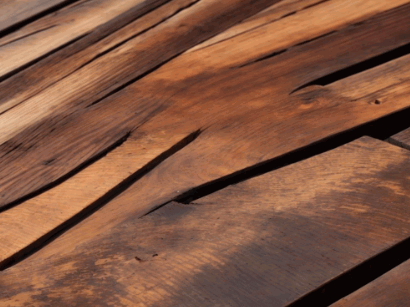
Chemical stripping involves the use of specialised cleaning products to dissolve and remove stubborn stains from the deck's surface, providing a comprehensive solution for deep cleaning.
There are various types of cleaning products available for this process, ranging from gentle water-based solutions to stronger solvent-based options. Water-based cleaners are often preferred for eco-friendly and easier-to-handle options, while solvent-based products offer more powerful stain removal for tougher stains.
When applying these cleaning products, it's essential to follow the manufacturer's instructions carefully. Typically, the product is spread evenly across the deck's surface and left to penetrate the stains before being scrubbed or rinsed off. Safety precautions, such as wearing gloves, protective eyewear, and ensuring proper ventilation, are crucial when working with these chemical solutions to protect yourself from any potential hazards.
Sanding is a manual technique that involves smoothing the surface of the deck by removing layers of wood to eliminate stains and imperfections, offering a labour-intensive yet effective method of restoration.
One of the key aspects of sanding for stain removal on decks is ensuring the right tools are at hand. Typically, you will need a power sander, sandpaper of varying grits, safety gear like goggles and a dust mask to protect yourself during the process.
It is not just about having the tools; proper technique is paramount to avoid damaging the deck's surface. Applying consistent pressure and moving in the direction of the wood grain is crucial to achieving a smooth finish without introducing scratches or uneven spots.
By taking the time to sand your deck correctly, you benefit from a surface that is ready to absorb stains evenly, enhancing its appearance and prolonging its lifespan. The effort put into sanding pays off in the form of a refreshed and rejuvenated deck that adds charm to your outdoor space.
Using a heat gun to remove deck stain involves applying controlled heat to the surface, softening the stain for easy removal without damaging the underlying wood, and providing a targeted solution for specific areas.
When using a heat gun for deck stain removal, safety should be a top priority. Wearing protective gear such as gloves and safety goggles is essential to shield oneself from potential heat exposure and flying debris. It's also crucial to work in a well-ventilated area to prevent inhaling fumes from the heated stain.
Proper technique is crucial for a successful outcome. Keeping the heat gun at a safe distance from the surface, typically 6 to 8 inches away, and moving it continuously to avoid scorching the wood is important. By maintaining a consistent pace and angle, you can effectively soften the stain without causing damage.
One of the key advantages of using a heat gun is its precision. Unlike other methods, a heat gun allows you to target stubborn stains accurately, avoiding unnecessary damage to surrounding areas. This targeted approach enables you to work efficiently on specific sections, achieving a more uniform finish in the stain removal process.
When done correctly by professionals or individuals with expertise, pressure washing can be safe for decks, as it effectively cleans surfaces without causing significant damage when using the right techniques.
It is crucial to highlight the safety concerns associated with pressure washing decks. Improper handling of the equipment or using excessive pressure can lead to damage to the wood surface, compromising the structural integrity of the deck. To avoid these risks, professionals are trained in assessing the appropriate pressure levels and techniques needed for different types of wood, ensuring that the cleaning process is thorough yet gentle.
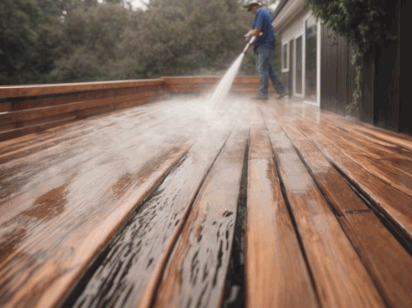
Taking precautions when pressure washing a deck is essential to prevent surface damage, preserve protective coatings, and ensure effective cleaning without compromising the structural integrity of the wood.
After pressure washing, make sure to allow sufficient time for the deck to dry completely before applying any new protective coatings to maintain the wood's resilience against the elements.
To safeguard your deck stain during pressure washing, consider using lower pressure settings, appropriate nozzle tips, and maintaining a safe distance to prevent direct damage to the stained surfaces.
Lower pressure settings are crucial as they reduce the risk of stripping off the stain from the deck surface. Choosing the right nozzle tip is equally important; using a wider fan pattern can help distribute the pressure evenly. Maintaining a safe distance from the surface allows for effective cleaning without harming the stain. After pressure washing, consider applying a protective sealant or topcoat to further safeguard the deck and prolong the life of the stain. These post-wash treatments can help maintain the integrity of the deck and protect against future damage.
Properly pressure washing a deck involves preparing the surface, selecting the right pressure and nozzle, and methodically cleaning the entire deck to remove dirt, stains, and debris effectively.
First and foremost, start by clearing the deck of any furniture, plants, or obstacles. Sweep the surface to remove loose dirt and debris, ensuring a clean workspace for the pressure washing process. Surface preparation is key to achieving optimal results.
Next, adjust the pressure washer to the appropriate setting based on the type of deck material and level of grime. Consider using a wider nozzle to cover more area or a narrower one for stubborn spots. Cleaning techniques such as starting from one end of the deck and working your way across in even strokes can help avoid streaks.
Finish off the process by rinsing the deck thoroughly and allowing it to dry completely before reapplying any sealants or finishes for post-wash maintenance.
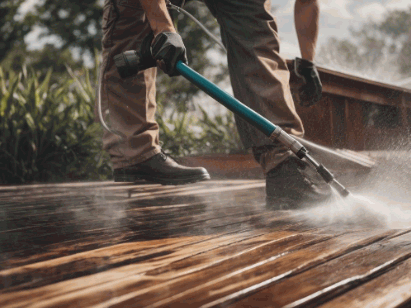
Before jet washing, prepare the deck by clearing any debris, removing loose dirt or grime, and ensuring the surface is ready for thorough cleaning to achieve optimal results.
Next, focus on removing loose dirt and grime using a stiff brush or broom. Pay attention to corners and edges where dirt tends to accumulate.
Selecting the appropriate pressure and nozzle tip is crucial for effective deck cleaning, as it determines the cleaning power and impact on different surfaces while avoiding potential damage.
Pressure washing decks involve a delicate balance between the force applied and the nozzle type used. The pressure level should be tailored according to the surface material, with higher pressure suitable for tougher surfaces like concrete and lower pressure for more delicate materials like wood.
Choosing the right nozzle tip is equally important, with wider nozzles dispersing pressure over a larger area, ideal for general cleaning, while narrow nozzles concentrate pressure for stubborn stains. Adjustable nozzles offer versatility, allowing you to customise the spray pattern based on the task at hand.
Begin pressure washing by applying water spray evenly across the deck's surface, moving consistently to cover all areas, and adjusting the pressure as needed to effectively remove dirt, stains, and grime.
When starting the pressure washing procedure on a deck, it is crucial to ensure a uniform application of water to prevent streaking or uneven cleaning. The motion should follow a systematic pattern, sweeping back and forth to maintain a regular flow over the entire surface. As you progress, adjusting the pressure appropriately ensures stubborn dirt and grime are efficiently lifted off without damaging the underlying material.